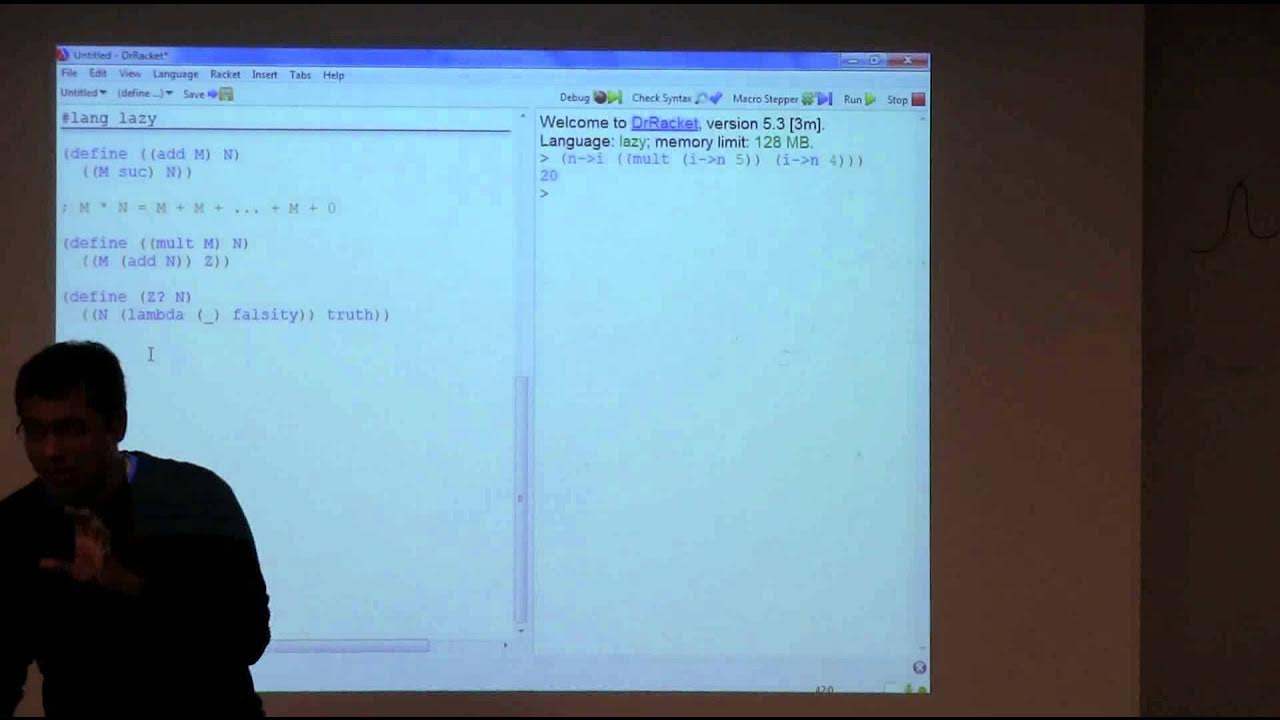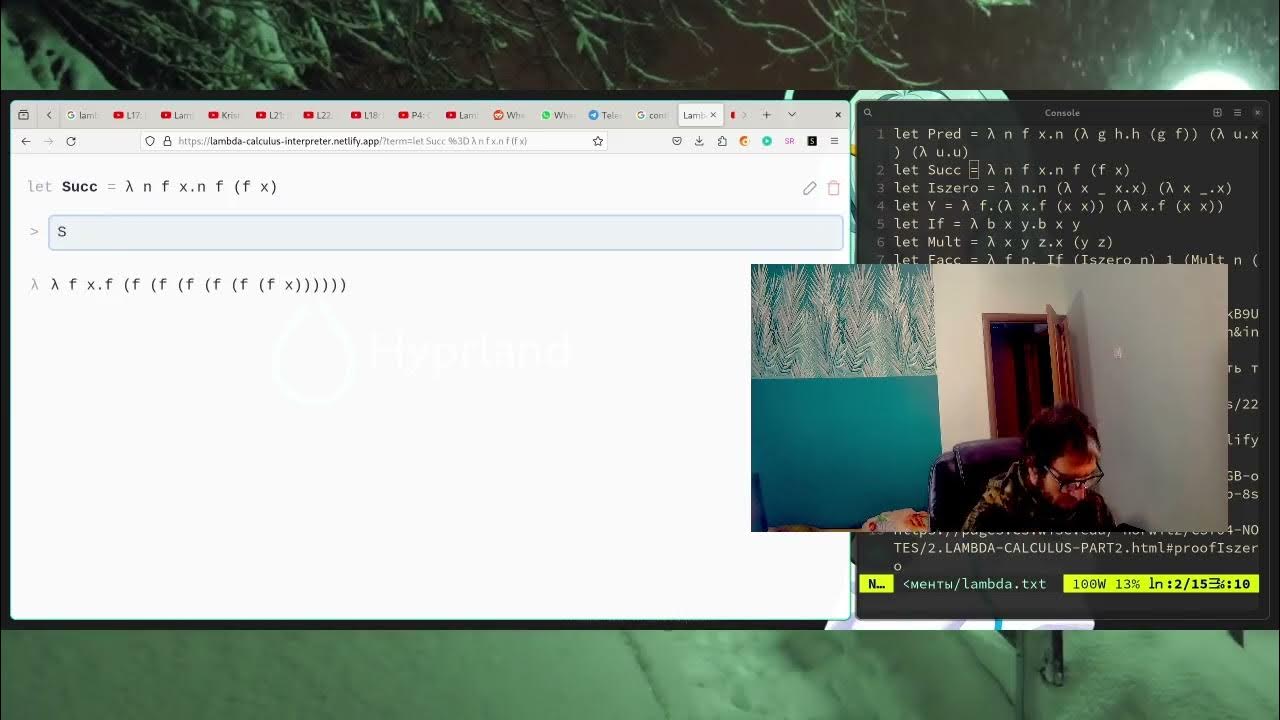The most intriguing discovery of Computer Science: the Y combinator demystified.
TLDRThe video script delves into the elegance and complexity of the Y combinator in computer science, a concept integral to lambda calculus—a minimalist yet powerful programming language. It explains how lambda calculus, despite its simplicity, can compute anything a traditional language like C can, by using function definitions and calls. The script explores representing basic types like booleans and numbers as functions and addresses the challenge of implementing recursion without variables, introducing the Y combinator as a solution. The explanation culminates in the Z combinator, which lazily evaluates functions to avoid stack overflow, exemplified by computing factorials.
Takeaways
- 🧠 The Y combinator is a complex yet beautiful concept in computer science, often misunderstood due to its difficulty level.
- 🌐 The context of the script is the search for the simplest programming language that can be as powerful as others, like C, which is lambda calculus.
- 📚 Lambda calculus is extremely basic, composed only of function definitions and calls, without loops, if statements, variables, or simple types.
- 🔢 Despite its simplicity, lambda calculus can compute anything a traditional language like C can, and it dates back to the 1930s.
- 🤔 The script raises two main questions: how to represent simple types and control structures like if statements, and how to handle loops and recursion.
- 👁️ In lambda calculus, even booleans and numbers are represented as functions, which is a counter-intuitive concept.
- 🔄 The Y combinator is introduced as a solution to handle recursion in lambda calculus, which cannot use variables or self-reference.
- 🔄 The script explains how to create an infinite loop in lambda calculus, which is a precursor to understanding the Y combinator.
- 🔄 The Y combinator is a function that takes another function as an argument and returns it, creating an infinite recursive call that never reaches the bottom.
- 🔄 The script demonstrates how the Y combinator computes the fixed point of a function, which is crucial for understanding recursion in lambda calculus.
- 🛠️ The Z combinator is introduced as a practical application of the Y combinator, allowing for lazy evaluation to avoid stack overflows in recursion.
- 🎓 The script concludes by congratulating the reader for understanding such a complex topic, emphasizing the intellectual challenge it presents.
Q & A
What is the Y combinator in computer science?
-The Y combinator is a function in lambda calculus that enables recursion. It is considered a fundamental concept in functional programming and is known for its complexity and elegance.
Why is lambda calculus significant in the context of programming languages?
-Lambda calculus is significant because it is a simple programming language that consists only of function definitions and calls. Despite its simplicity, it is Turing complete, meaning it can compute anything a more complex language like C can.
What are the limitations of lambda calculus in terms of programming constructs?
-Lambda calculus does not support loops, if statements, variables, or simple types like booleans or numbers. It is strictly about defining and calling functions.
How can lambda calculus represent boolean values without using traditional boolean types?
-In lambda calculus, boolean values are represented as functions. 'True' is a function that takes two arguments and returns the first one, while 'False' takes two arguments and returns the second one.
What is the identity function in lambda calculus, and how is it written in JavaScript?
-The identity function is a function that takes one argument and returns it unchanged. In JavaScript, it can be written as an arrow function with the syntax `x => x`.
How can we define the NOT operator in lambda calculus?
-The NOT operator can be defined in lambda calculus by creating a function that takes a boolean function as an argument and returns the opposite boolean function. For example, NOT(TRUE) would return FALSE.
What is recursion, and why is it important in programming?
-Recursion is a programming technique where a function calls itself to solve a problem. It is important because it allows for elegant solutions to problems that involve repeated operations or hierarchical structures.
How does the Y combinator enable recursion in lambda calculus?
-The Y combinator enables recursion by allowing a function to refer to itself without being named or assigned to a variable. It creates an infinite series of function calls that approximate the desired recursive behavior.
What is the concept of a fixed point in the context of the Y combinator?
-A fixed point in the context of the Y combinator is a function that, when applied to itself, returns itself. The Y combinator computes the fixed point of a given function, allowing for recursion.
What is the Z combinator, and how is it related to the Y combinator?
-The Z combinator is a variation of the Y combinator that performs lazy evaluation of the recursive call. Instead of computing an infinite series of function calls, it computes them only when necessary, avoiding stack overflow issues.
How does the script illustrate the concept of lazy evaluation in the context of the Y combinator?
-The script illustrates lazy evaluation by showing how to replace the infinite recursive call g(g) with a function that computes it only when called, thus avoiding the infinite loop and enabling practical use of the Y combinator.
Outlines
🤖 Introduction to the Y Combinator and Lambda Calculus
The video script introduces the Y combinator as a complex yet beautiful concept in computer science, particularly within the realm of lambda calculus. Lambda calculus is a minimalist programming language composed solely of function definitions and calls, lacking loops, if statements, variables, and simple types. Despite its simplicity, it is Turing complete, meaning it can compute anything a more complex language like C can. The script sets the stage for an exploration of how lambda calculus can represent complex programming constructs like numbers, booleans, and control structures, and how the Y combinator addresses recursion without the use of variables.
🔁 Recursion and the Y Combinator in Lambda Calculus
This paragraph delves into the intricacies of recursion in lambda calculus, a system without variable assignment. It discusses how to create a function that refers to itself without using variable names, by passing the function as an argument to itself. The script introduces 'factorial_gen', a function that takes a factorial function as an argument and returns a modified version of it. It also explains how an infinite series of function calls can be represented and how the Y combinator is used to compute these calls. The Y combinator is portrayed as a tool for creating fixed points of functions, which is essential for enabling recursion in lambda calculus.
🔄 The Z Combinator and Lazy Evaluation in Lambda Calculus
The final paragraph of the script discusses the practical application of the Y combinator, specifically in the context of the factorial function. It explains the problem of infinite recursion and how the Z combinator, a variation of the Y combinator, addresses this by introducing lazy evaluation. This approach allows the computation of the factorial function to occur only when necessary, avoiding stack overflows. The script concludes by highlighting the complexity and elegance of these concepts, inviting the viewer to appreciate the depth of lambda calculus and the Y combinator's role in enabling recursion.
Mindmap
Keywords
💡Y Combinator
💡Lambda Calculus
💡Recursive Function
💡Fixed-Point Combinator
💡Function as a Value
💡Anonymous Functions
💡Booleans in Lambda Calculus
💡NOT Operator
💡Infinite Loop
💡Lazy Evaluation
💡Z Combinator
Highlights
The Y combinator is a complex yet elegant concept in computer science that allows for recursion in lambda calculus without variable assignment.
Lambda calculus is a simple programming language composed only of function definitions and calls, yet it is as powerful as languages like C.
Lambda calculus does not include loops, if statements, variables, or simple types like booleans or numbers, but it can still compute anything a modern language can.
Modern programming languages refer to anonymous functions as 'lambdas', inspired by lambda calculus.
In lambda calculus, functions are defined with arguments on the left side of an arrow and the returned value on the right.
Functions in lambda calculus can take other functions as arguments, showcasing the power of higher-order functions.
The challenge of representing simple types like booleans and numbers in a language that only defines functions is addressed by using functions as their representation.
Boolean values TRUE and FALSE are represented as functions in lambda calculus, with TRUE returning its first argument and FALSE its second.
Classic boolean operators like NOT can be defined in lambda calculus by utilizing the functions representing TRUE and FALSE.
The concept of defining numbers and simple if statements within lambda calculus is introduced as a shortcut to make examples more readable.
The Y combinator solves the problem of recursion in lambda calculus by allowing a function to refer to itself without using variable assignment.
The factorial function serves as an iconic example of recursion, and its implementation is explored in the context of lambda calculus.
The Y combinator is constructed by creating an infinite loop with a function that calls itself with its own argument.
The Y combinator is generalized to work with any function 'f' by passing it as an argument and returning a modified version of itself.
The fixed point of a function is a concept utilized by the Y combinator, where the function is applied to itself infinitely many times.
The Z combinator is introduced as a variation of the Y combinator that performs lazy evaluation to avoid stack overflow issues.
The practical application of the Y and Z combinators is demonstrated by computing the factorial function without causing a stack overflow.
The video concludes by congratulating viewers for understanding the complex concepts of the Y and Z combinators and their applications in lambda calculus.
Transcripts
Browse More Related Video

Essentials: Functional Programming's Y Combinator - Computerphile

Lambda Calculus: The foundation of functional programming, and the simplest programming language

Programming Languages - The Lambda Lecture

Lambda Calculus Calculator

Factorial with lambda calculus

Y combinator and recursion in haskell (implement fib without recursion)
5.0 / 5 (0 votes)
Thanks for rating: